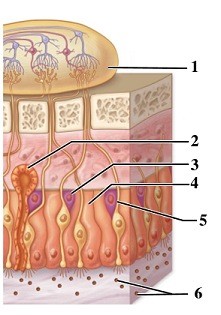Taste buds are not associated with _____ papillae
A. foliate
B. filiform
C. fungiform
D. vallate
E. papilliform
B
You might also like to view...
 In this view of the olfactory organs, what structure does number 3 indicate?
In this view of the olfactory organs, what structure does number 3 indicate?
A. Basal cell B. Olfactory bulb C. Axon of olfactory receptor cell D. Olfactory receptor E. Olfactory hairs
Which of the following is an example of negative feedback?
A) An increase in normal body temperature triggers heat loss through enhanced blood flow to the skin and increased sweating. B) An increase in ambient room temperature triggers the thermostat to turn on the heater. C) A severe cut triggers accelerated blood clotting until the bleeding stops. D) Increased blood sugar stimulates the release of a hormone from the pancreas that stimulates the liver to release blood sugar. E) An increase in body temperature triggers a neural response that initiates physiological changes to increase body temperature.
The intestinal hormone secretin is released by endocrine cells in the duodenal mucosa in response to
a. distention of the stomach. b. carbohydrate in the duodenum. c. acid in the duodenum. d. gastrin secreted by the pyloric gland area of the stomach. e. none of these answers.
The ability of a muscle to be stimulated is called
A) contractility. B) elasticity. C) extensibility. D) excitability.